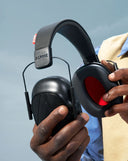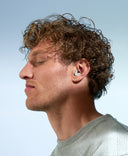Exposure to loud noises can cause hearing damage. You can prevent this by wearing hearing protection. Not all earplugs have the same level of attenuation, however. By looking at the SNR value of earplugs, you can determine if they provide sufficient attenuation for the volume to which you are exposed. But what exactly is SNR value?
Differences between SNR and NRR
SNR and NNR are both values expressed in decibels (dB) that provide an indication of the average attenuation of hearing protection. However, there are differences between SNR and NRR.
What is SNR?
SNR stands for Single Number Rating. It is a European standard that uses a single number rating system according to the International Organization for Standardization ISO 4869. The SNR value provides an indication of the attenuation of the frequency range relevant to humans. You can assume that earplugs with an SNR value of 19, attenuate the sound you hear by about 19 dB.
What is NRR?
NRR stands for Noise Reduction Rating. This is the rating system of the American National Standards Institute (ANSI), used in the United States. There is no exact calculation method to convert an SNR value to an NRR value. But you can make an estimate; SNR values are about 3 to 5 dB higher than NRR values. An earplug with an SNR value of 25 would have an NRR value of about 21 . But if you're curious about the NRR value, you don't always have to estimate. In fact, many of our products list an NRR value in addition to an SNR value. For the PartyPlug, for example, this is 16.5-21.5.
What does the SNR value for earplugs mean?
If you are planning to purchase hearing protection, you naturally want to be sure you are buying a safe and reliable product. The SNR value of earplugs is therefore determined by testing the earplugs in independent laboratories. The rating allows you as the end user to judge whether the attenuation level of the earplugs is sufficient for the volume to which you are exposed. You subtract an earplug's SNR value from the average noise level to which you are exposed. The result is the average sound exposure on your ears with earplugs inserted.
Example: you go to a party at a nightclub. The average volume of the music there is 99 dB. That can cause hearing damage within a short time, so start looking at suitable earplugs for festivals and music. Unsure between an SNR value of 19 or 21? The Alpine PartyPlug earplug has an SNR of 19. This means that the sound exposure on your hearing with these earplugs averages 99 - 19 = 80 dB. The Alpine PartyPlug Pro earplug has an attenuation of 21 dB. So it attenuates a bit more - the sound exposure on your hearing is then just under 80 dB.
In short, by looking at the SNR value, you can compare the noise reduction of different earplugs and thus make an informed choice.
It is good to know that the risk of hearing damage begins as early as 80 dB. After 8 hours at this level, the probability of damage increases; for every 3 dB added, the safe time is halved. Want more information about what a decibel is? Read our blog explaining more about the concept of decibels (dB)!
SNR is an average value
Basically, you can assume that the higher the SNR value is, the more dB the hearing protection attenuates. Keep in mind that the SNR value is a basic average. This is because an earplug attenuates differently on low tones than on high tones. To find out the actual attenuation, compare an earplug at different frequencies.
Attenuation value at different frequencies
To determine the attenuation value at different frequencies, we use the H, M and L values:
H: High frequencies between 2000 and 8000 Hz
M: Medium frequencies between 1000 and 2000 Hz
L: Low frequencies between 63 and 1000 Hz
For the PartyPlug earplugs, these values are as follows:
H: 19
M: 17
L: 12
If we include the attenuation value table for the PartyPlug earplug, it looks like this. In it, you can see exactly how much the earplug attenuates at what frequency.
|
Hz |
63 |
125 |
250 |
500 |
1000 |
2000 |
4000 |
8000 |
|
dB |
8.8 |
10.3 |
13.2 |
16.6 |
20.6 |
25.4 |
25.2 |
19.2 |
This article is for informational purposes only and does not replace medical advice. Have questions about your health? Contact a doctor or healthcare professional.




